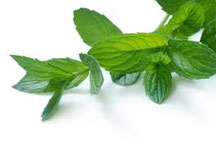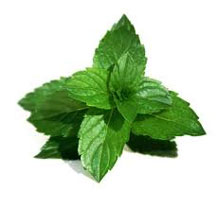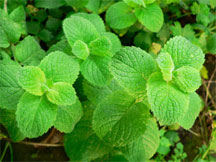Mint: It Does More than Freshen Breath
By Alice Osborne
 The humble mint plant ought to receive more attention and raves than it does, because it is far more than a breath freshener! Mint is one herb anyone with blood sugar issues wants to consume on a daily basis, since we need to be extra careful about keeping our immune system strong and conscientious about side-stepping typical seasonal maladies such as the flu.
The humble mint plant ought to receive more attention and raves than it does, because it is far more than a breath freshener! Mint is one herb anyone with blood sugar issues wants to consume on a daily basis, since we need to be extra careful about keeping our immune system strong and conscientious about side-stepping typical seasonal maladies such as the flu.
 Mint contains a number of vitamins and minerals, which are vital to maintain a healthy body. Mint is rich in Vitamins A and C and also contains smaller amounts of Vitamin B2. Vitamin C is an important antioxidant and may help to decrease the risk of certain cancers such as colon and rectal cancer. And it doesn’t take a lot of this plant for the body to reap mint’s benefits.
Mint contains a number of vitamins and minerals, which are vital to maintain a healthy body. Mint is rich in Vitamins A and C and also contains smaller amounts of Vitamin B2. Vitamin C is an important antioxidant and may help to decrease the risk of certain cancers such as colon and rectal cancer. And it doesn’t take a lot of this plant for the body to reap mint’s benefits.
Mint also contains a wide range of essential minerals such as manganese, copper, iron, potassium and calcium. It has a long history of being used medicinally to aid digestion and relieve indigestion. So if you suffer from frequent indigestion, drinking a cup of peppermint tea after your meal can help.
The chemical compound menthol, which is obtained from peppermint oil, is well known for its healing properties on the chest and respiratory system. And mint has also been proven to:

- First and foremost, mint is a very good cleanser for the blood.
- Relieves the symptoms of colds and flu.
- Act as a powerful antioxidant, protecting the body against the formation of cancerous cells.
- Inhibit the growth of many different types of bacteria and fungus.
- Relieve symptoms of indigestion, heartburn and irritable bowel syndrome by relaxing the muscles in and around the intestine.
- Ease and unblock the breathing and respiratory passages and airways.
- Mint can help with nasal allergies.
- It can relieve congestion, head colds and headaches.
- Act as a mild sedative and has calming properties.
- Relieve minor aches and pains such as muscle cramps and sprains.
- Provides a cooling sensation to the skin and can help to treat minor burns, itching and skin irritations.
- Mint tea can help clear up skin disorders such as acne.
Mint is a versatile plant with lots of ways to contribute to our cooking and baking. Consider these ideas, then try the recipe below:

- Add chopped mint to sauces for red meat, particularly lamb.
- Add several sprigs of mint to peas, green beans or new potatoes whilst boiling.
- Add mint to a homemade or pre-prepared chocolate sauce for a choc and mint sauce.
- Use as a garnish for cool drinks and fruit desserts.
- Use dried peppermint leaves, added to boiling water to make a refreshing and digestive tea.
- Make a yoghurt dressing with chopped mint leaves, natural yoghurt, garlic and salt and pepper for salads especially cucumber salad.
- Add to cold soups or hot tomato soups.
- Use to make curries.
- Use mint to flavor cakes, meringues and biscuits.
- Use to make a marinade for lamb.
- The Middle Eastern salad dish, Tabbouleh contains mint, bulgur, parsley, red onions, tomato and lemon juice.
- Add chopped mint to rice, chickpea, couscous or bean dishes.
Roasted Summer Squash with Lemon and Mint
(Makes about 4 servings, recipe adapted from Vegetable Love.) 6 yellow summer squash or zucchini, about 8 inches long
6 yellow summer squash or zucchini, about 8 inches long
1/4 cup olive oil
1/4 cup lemon juice
1/2 cup very finely chopped mint (measure after chopping)
salt to taste (I used about 1/2 tsp.)
Preheat oven to 475 F, and put oven rack as high as it will go. (The recipe actually called for 500 F, but the highest my toaster oven goes is 450 F with convection, which is the equivalent of 475 F without convection.)
Wash squash and cut off stem and flower ends. Cut each squash into quarters lengthwise, then cut into pieces about 2 inches long. Combine olive oil, lemon juice, mint and salt in plastic bowl and toss squash with the mixture. Spray roasting pan with nonstick spray or mist with olive oil. Arrange squash on roasting pan, in a single layer as much as possible. Roast squash, turning every 15-20 minutes, until well done and slightly browned. Turn squash twice, with a total cooking time of 45 minutes.

Contribute to the Cook'n Club!
DVO would love to publish your article, prose, photography and art as well as your cooking, kitchen and nutrition tips, tricks and secrets. Visit the Newsletter Submission / Win Win for All section in our Forum for more information and details.

